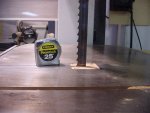Evening Brett...
That's about where mine is directly off the pallet and it presents no problem. The blade clears insert sides nicely and I added the zero insert anyway. It's made of plastic. I also drilled 3 holes with a forstner on each side so what little dust ends up top table drops or gets sucked down by the vacuum from the DC port. Effort on your part but it relays to we know the saw even better after you accomplised it so your effort has attained value.
Here's the e-mail I mentioned concerning the review by Roland Johnson. JIm sent another e-mail concerned a blatant error RJ made on a Spindle Sander review in FWW Tools and Shops recently. RJ may be wood-worker but I highly question his know-ledge of machinery and IMO shouldn't be priinted as many are going to read his reviews and not have enough personal knowledge to question. In other words.. blind faith in what appears to be an expert based on the fact he was printed. He could be an expert?... but not on Machinery!
*********************************************************
Hello Sarge,
Here is the reply on the bandsaw review that Roland Johnson did. Let me know what you think of it.
Best Regards,
Jim Box
**********************************************************
Steel CityIn reference to Roland Johnson’s review of the Steel City 18” bandsaw in the February issue of Fine Woodworking magazine, I would like to clarify a few points regarding our saw:
First, Mr. Johnson stated that “the upper guide post flexed enough to allow the thrust bearings to flex out of alignment, which caused the blade to twist during resawing.” A few paragraphs later in the article, Mr. Johnson stated that “the upper blade guide mounting bracket was not at 90° to the blade, creating a twist in the blade between the upper and lower guides.” Our bandsaws are equipped with an adjustable guide-bar bracket. This bracket can be adjusted in any direction to align the guide bearings to the blade at a perfect 90° angle, which would have eliminated the problem Mr. Johnson describes. Such adjustments are the responsibility of the customer.
When we designed this saw, we added many new adjustment features to combat the common bandsaw problems that we observed in the marketplace. With these new adjustability features we forgot one thing, and that was to really clarify their functions in the manual. This has caused some confusion for end users who are trying to understand what is causing a particular symptom and how to correct it. For this we apologize. We are in the process of revising the manual and the new version should be posted on our website by mid-January.
Mr. Johnson also stated the saw table had a .012” crown in the middle of the table and a .024” disparity at the blade slot when the alignment pin was removed. This is to be expected and is by no means an indicator of poor quality control. The table will move when the alignment pin is removed, but once the alignment pin is re-inserted, the table surfaces will again line up perfectly.
It is important to understand that cast-iron tables will always have stress conditions at various points around their perimeters when they are assembled to machines. In the case of bandsaw tables, these stresses result when the trunnions are tightened. When we ship the saws from our factory, the table is shipped separately and must be installed by the customer. There are two aluminum trunnion quadrants mounted to the underside of the table that must mate up with the cast-iron trunnion cradles so that the table can tilt. If the mating surfaces do not mate together properly, the above described condition can result.
This is not a defect and the remedy is simple: Loosen the bolts holding the aluminum quadrants to the table, tighten the lock knobs, then re-tighten the quadrants. The cast-iron trunnion that supports the table are fully adjustable to the saw cabinet. This assures that the table can be set at a perfect 90° to the blade.
Mr. Johnson also noted that the thumbscrews securing the guides are too small. On this we agree and have since upgraded them to a larger size.
Although we try to set up the saws as accurately as possible at the factory, some fine tuning will generally be required once the unit is assembled. We regret it if our manual didn’t adequately outline the procedures required to perfectly tune the saw.
Best Regards,
Jim Box, Technical Supervisor
Tool Works
*********************************************************
Regards...
JT.. sarge





